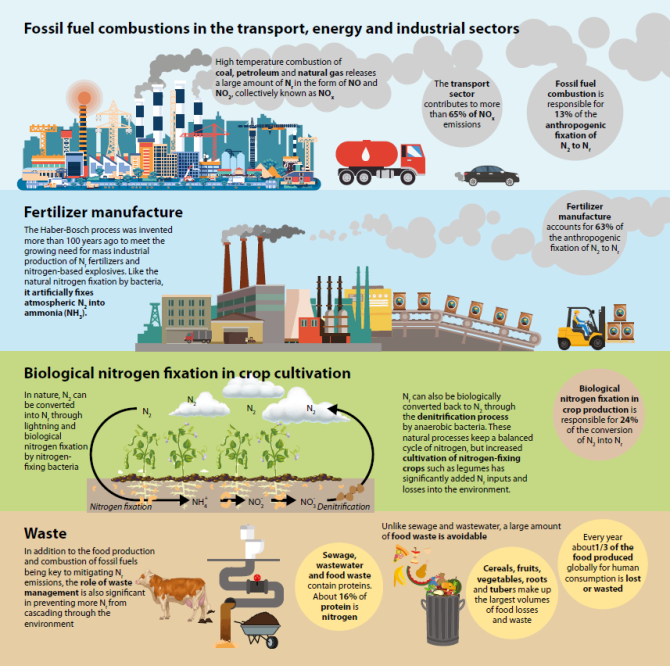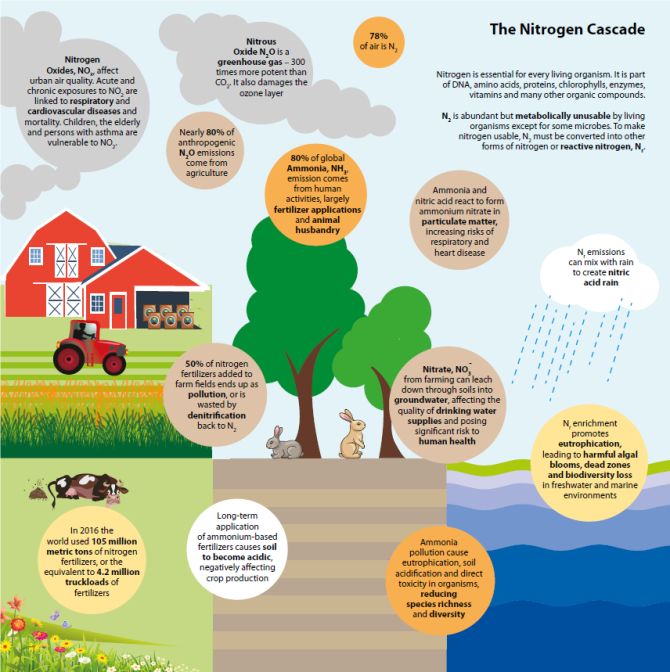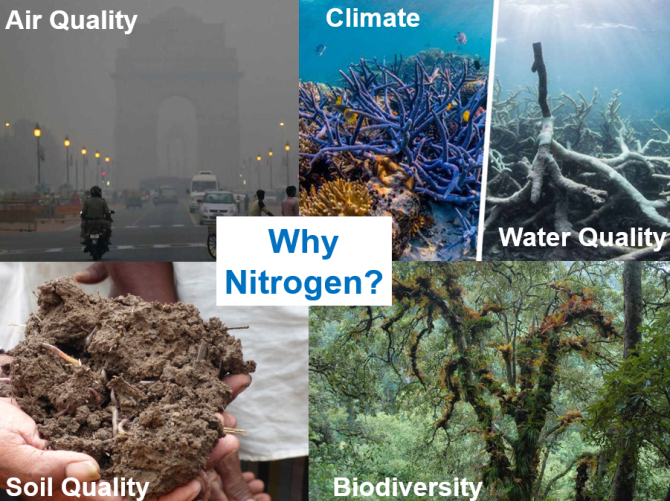Sustainable nutrient management
The nutrients nitrogen (N) and phosphorus (P) are crucial for food production but are currently used inefficiently: some parts of the world have too much, while other parts have too little. WIMEK scientists use models to reveal nutrient flows and impacts, and show what measures are needed. They also develop technologies for removing and reusing the nutrients.
Background
Food security depends on inputs of nitrogen (N) and phosphorous (P) in food production. However, inputs are unevenly distributed across the planet: there is not enough nitrogen and phosphorous to maintain soil fertility in developing countries, yet there are surpluses in developed and emerging economies. Many inputs are lost to the environment, together with N emissions from traffic and industry (Figure 1), which results in air, soil and water pollution with impacts on health and biodiversity such as dead zones in coastal oceans and harmful algal blooms (Figure 2 and 3). Nitrogen use also affects climate change, for example through the warming effect of nitrous oxide emissions.
I am fascinated by the study on sustainable nutrient management, especially related to nitrogen, because of the multiple interacting impacts of multiple nitrogen sources on health, biodiversity and climate.
Because of these effects, planetary boundaries have been set for the use of nitrogen and phosphorous, but the boundaries do not take into account the variation in the nutrient inputs and associated problems around the world. WIMEK aims to provide that detailed knowledge and work towards sustainable nutrient management.
Research objectives and approach
Key objectives of WIMKEK’s nutrient research are:
- To determine the fate and effects of nutrient flows in terrestrial and aquatic systems.
- To determine the overall impact of nitrogen use on greenhouse gas emissions.
- To give regional boundaries for nitrogen losses, surpluses and inputs.
- To assess the required increase in nutrient use efficiencies to reconcile food production and regional boundaries.
- To enable the removal, recovery and reuse of nutrients from wastewater.
- To improve nutrient management for food production and trade-offs with the provisioning of water and energy in urban areas.
- To evaluate policy options for stimulating organic waste applications, replacing nitrogen and phosphorous fertilizers.
WIMEK’s research approach is multidisciplinary, with a focus on comprehensive modelling across different scales (landscapes, water basins, countries, continents and world). The models let us identify the main causes and impact of nutrient losses, and the effectiveness of interventions, taking into account the local conditions. Scenario analyses provide insight into the effects of socio-economic developments. An example of this comprehensive approach is our integrated analysis of the impacts of nitrogen use on soil, air and water quality and the related effects on crop yields, biodiversity and forest growth and the related boundaries for nitrogen losses and inputs in view of those impacts with a focus on EU countries and China. In addition to models, we also develop new technologies, for example for recovering nutrients from domestic wastewater, which could satisfy a quarter of the current demand for phosphorus.
Stakeholder involvement
The research is performed in close collaboration with relevant stakeholders, including government regulators, environmental agencies, fertilizer industries and farmers’ organizations. This guarantees that research results are used in policy-making and farm management. The modelling approaches by WIMEK are thus used to support spatially-explicit policies to improve nutrient management.
Studies on sustainable nutrient management is highly relevant for society, not in the least for the Netherlands that struggles with a nitrogen crisis, considering the large potential to improve the current situation.
Link to education
WIMEK’s research on nutrients is used in education where we teach students how to assess the impacts of nutrient management on agricultural production and on the environment. This includes modelling approaches to evaluate the effects of policy scenarios and management options on the environmental quality and model linkages for integrated assessments.
Research highlights
Our work has resulted in (contributions to) many highly cited papers in prestigious journals, such as Science, Nature and Nature Sustainability. The research is also highly valued by funding organizations, as evidenced by the large number of research grants.
Our research is related to all three of WIMEK’s Grand Challenges: climate action, managing our future biosphere and advancing circular systems. We give three research highlights in these three areas:
- Climate action: We showed that at the global scale the estimated CO2 uptake due to nitrogen inputs in terrestrial, freshwater and marine ecosystems largely offsets the stimulating effect on N2O emissions (on average by nearly 75 per cent). However, this effect is partly reduced by NOx-induced O3 exposure, which reduces CO2 uptake, so the overall compensation is closer to 60 per cent.
- Managing our biosphere: We showed that a reduction of nearly 50 per cent in nitrogen losses and inputs is needed at the global and EU scales. In highly cited papers, we present those results in terms of a planetary boundary for phosphorous inputs, nitrogen losses, surpluses and inputs. The required reduction of 50 per cent losses is now mentioned in the Colombo Declaration on sustainable nitrogen management for the world and the EU’s Green Deal.
- Advancing circular systems: A study showed that the environmental impact of food production will increase by 50 to 90 per cent by 2050 in a business-as-usual scenario. Only a combination of dietary change, waste reduction, circular agriculture and ambitious new sustainable technologies can reverse this trend sufficiently.
Impact
WIMEK’s nutrient research, for example on the potential to feed the world sustainably with respect to nutrient use in 2050, has attracted considerable media attention, both in the Netherlands and abroad. This allows us to communicate our research findings not just to the general public but also to the business community such as food companies.
In the Netherlands, our research is in the spotlight because of the Dutch ‘nitrogen crisis’, following a high court ruling that the government needs to take immediate action to reduce nitrogen emissions. WIMEK researchers’ findings on the required reduction in nitrogen emissions to protect nature sites are informing government policy.



Sutton M., Raghuram N., Adhya T.K., Baron J., Cox C., de Vries W., Hicks K., Howard C., Ju X., Kanter D., Masso C., Ometto J.P., R. Ramachandran, van Grinsven H., Winiwarter W., 2019. The Nitrogen Fix: From nitrogen cycle pollution to nitrogen circular economy. Frontiers 2018/2019: Emerging Issues of Environmental Concern. pp 52-65, United Nations Environment Programme, Nairobi. ISBN: 978-92-807-3737-0